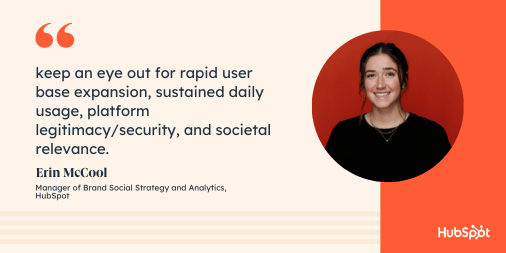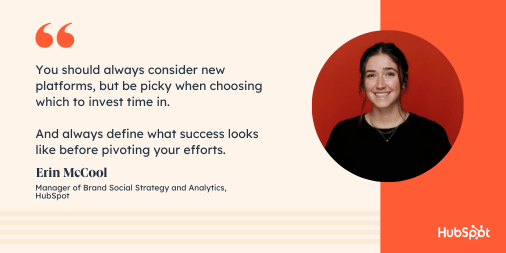
Like dozens of other “Twitter killers,” Bluesky has sat in limbo since its launch– thanks mostly to an invite-only policy.
But when the micro-blogging site went public last month, it skyrocketed to an estimated 4 Million users almost overnight.
That kind of growth can be chum in the water for marketers. But is the social media startup worth your time?
I sat down with HubSpot’s Manager of Brand Social Strategy and Analytics to find out.
But first, let’s jump back a bit for those who don’t know what Bluesky is.
What is Bluesky?
Bluesky is one of dozens of social media apps that have popped up in the hopes of X (formerly Twitter) dying off.
It joins the ranks of micro-blogging sites like Mastodon, Threads, Plurk, Cohost, Compost, Sparklefyre, and Snuffleupagus. (Admit it. You have no idea which of those I just made up. That’s how many X-alternatives there are.)
So, what sets Bluesky apart from the others?
Bluesky was designed as an open-source social media app built on a decentralized infrastructure (called the AT Protocol) and funded by Twitter co-founder Jack Dorsey.
That’s a mouthful. But what exactly does it mean?
- Open source means the code is available for anyone to see (or even tinker with).
- Decentralized means that anyone can host a version of Bluesky on their own server.
That combo gives users a lot more transparency into how the platform works. It also gives them a lot more agency when something goes wrong.
For example, if you don’t like what the Facebook algorithm serves you, there’s not much you can do.
But if you don’t like the Bluesky algo? You can just launch your own Bluesky. (Blackjack optional.)
When Bluesky was invite-only, it had gathered an estimated 3 Million monthly active users. Compare that to the 130 Million users claimed by Threads.
But when Bluesky opened up to the public in early February, it jumped by 800,000 users in a single day.
It’s even attracted celebs like Chrissy Teigen and Neil Gaiman, as well as major media outlets like The New York Times and The Washington Post.
So, should your company be counted among those names?
Should your business be on Bluesky?
To get the scoop on all things social, I spoke with Erin McCool, HubSpot’s Manager of Strategy and Analytics, Brand Social.
Let’s start by putting our money where our mouse is…
Is HubSpot on Bluesky, or do we plan to be?
“Currently, we’re not on Bluesky, and there are no immediate plans to join,” McCool says. “When it began as invitation-only, it was less of a priority for us because, naturally, fewer individuals within our target audience will have access to join.”
But that may not be the case for every business. As a B2B SaaS, HubSpot may have a very different audience than yours.
It’s important to identify your audience and meet them where they are.
But don’t forget, the world of social media is always moving. Where your audience is today might change tomorrow.
“We are always monitoring emerging platforms because the social landscape moves quickly, so we’ve got to be ready to move with it,” she adds.

So, when should marketers pay attention to a new social channel?
“I’d keep an eye out for rapid user base expansion, sustained daily usage, platform legitimacy/security, and societal relevance,” McCool explains.
Remember those 130 Million Threads users I mentioned earlier?
“When Threads launched last summer, it hit all those factors- we joined the platform quickly,” she says. “We’ve since grown our following to 90k, organically!”
But that kind of growth won’t happen if you spread your time and talent across too many platforms.
How does HubSpot’s social team choose which platforms to focus on?
“We’re constantly auditing our target audience’s preferences and habits– alongside our own social performance– to refine our content strategy,” Erin says. “As well as how and where we show up in the social world.”
Pro tip: Not sure what to look for? You can learn more about what she means in our Social Media Analytics: The Ultimate Guide.
But it’s not just about numbers.
“We also want a combination of platforms that allow us to diversify our content formats,” McCool explains.
Think about the difference between LinkedIn, TikTok, and Instagram. Each platform works best with a different format, and each format will allow you to speak to a different segment of your audience.
If you only engage on micro-blogging platforms, you could be limiting your reach.
Just don’t go too far in the other direction, either.
“Entering a new platform is an investment of time and effort, so we align our decisions with what we feel will drive lifelong engagement and brand growth.”

And that gets to the heart of the matter: There are so many social media platforms that even with a team of marketers, you still have to decide where to invest that time and effort.
So now, bottom line:
Should our readers consider Bluesky?
“You should always consider new platforms, but be picky when choosing which to invest time in,” she advises. “And always define what success looks like before pivoting your efforts to a new platform.”
In other words, don’t join a platform just to join. Remember that you’re there to promote your brand.
Instead of asking yourself, “Should we join this platform?” McCool suggests you prioritize questions like:
- “Is our audience here?”
- “Do the content features match our capabilities?”
- “Do we have the resources to sustain this presence?”
And, finally, remember that you don’t have to decide right away. McCool adds one more piece of wisdom:
“It never hurts to secure your brand’s handle while you experiment on the platform from your personal account.”







